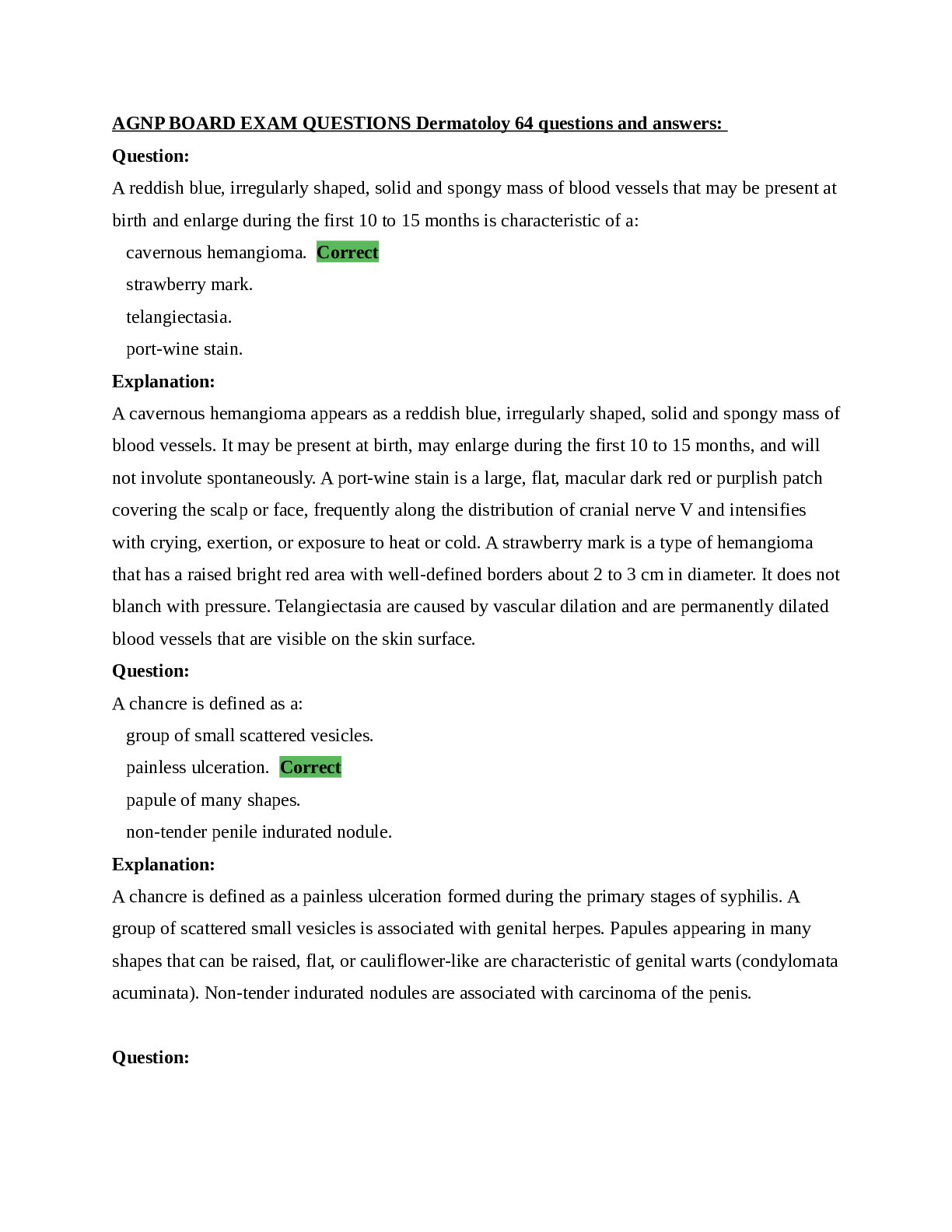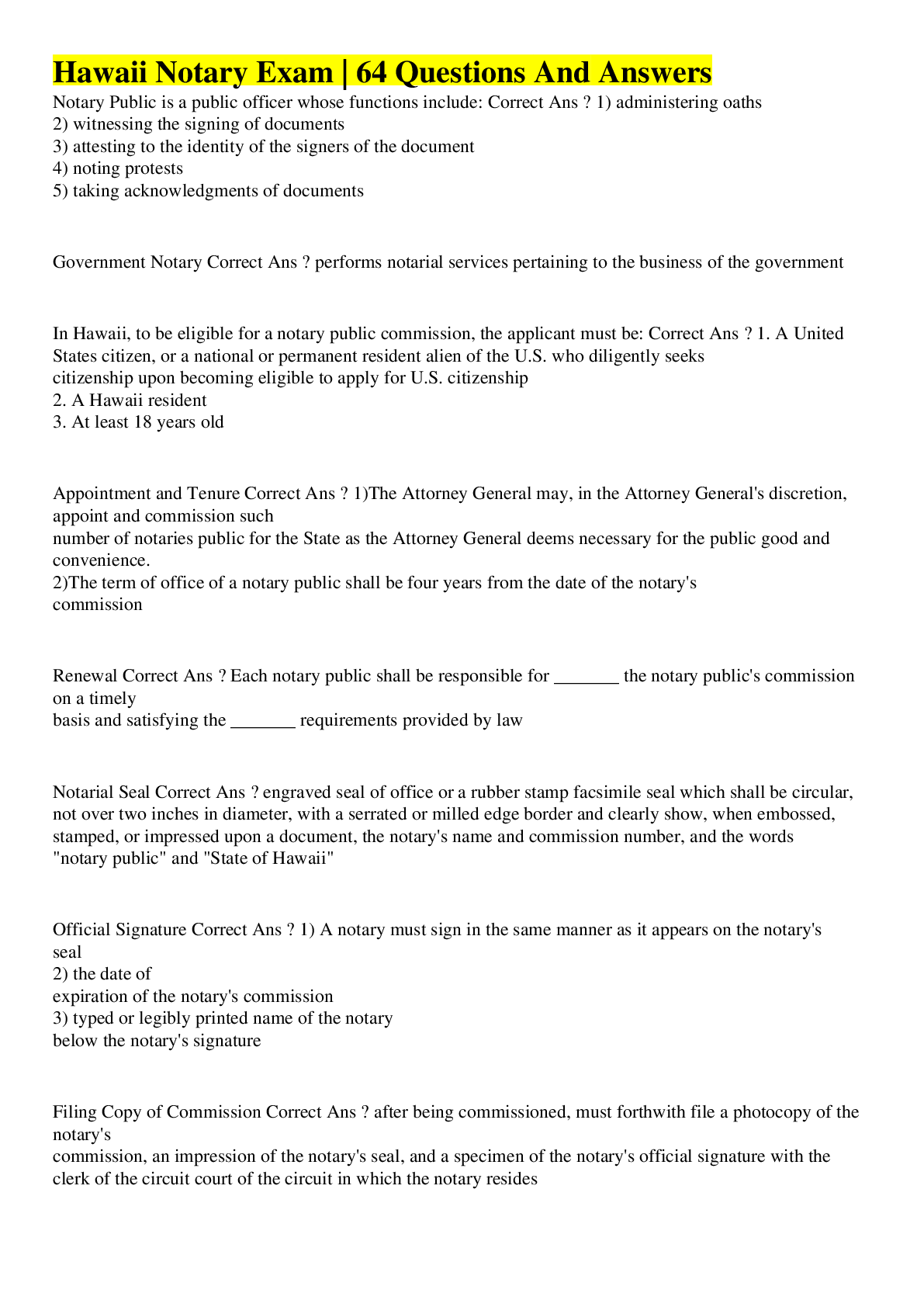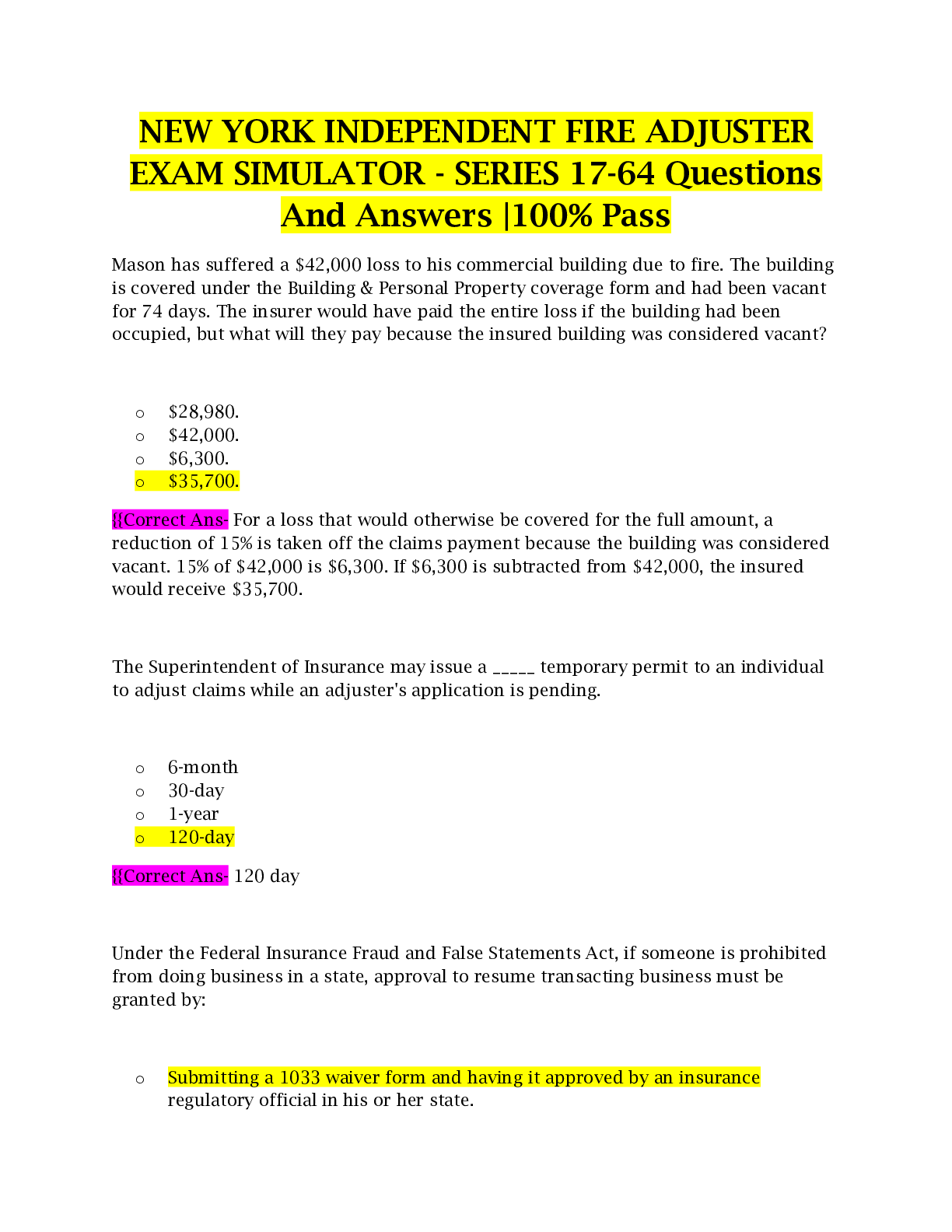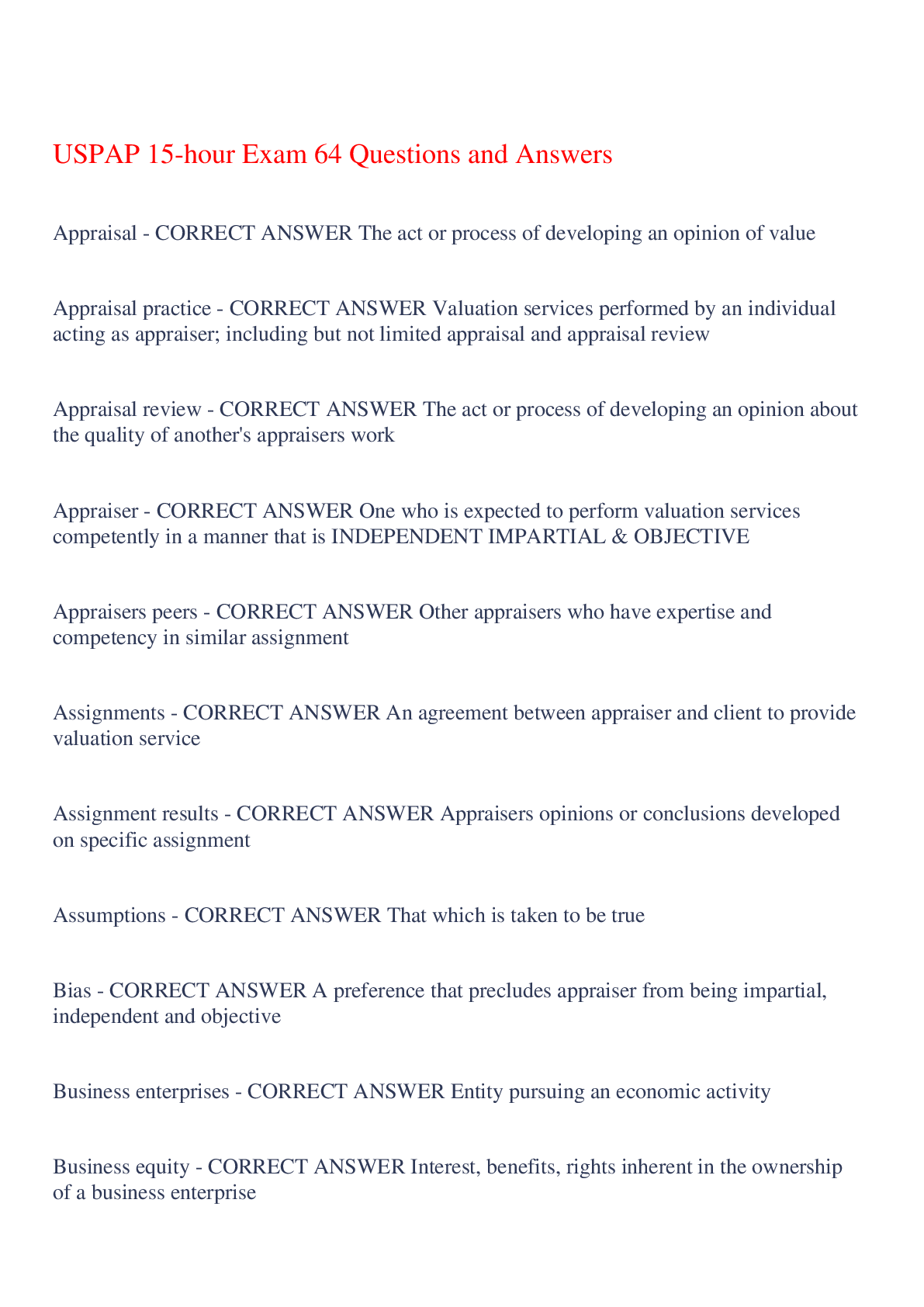*NURSING > EXAM > AGNP BOARD EXAM QUESTIONS Dermatoloy 64 questions and answers: ,100% CORRECT (All)
AGNP BOARD EXAM QUESTIONS Dermatoloy 64 questions and answers: ,100% CORRECT
Document Content and Description Below
A reddish blue, irregularly shaped, solid and spongy mass of blood vessels that may be present at birth and enlarge during the first 10 to 15 months is characteristic of a: cavernous hemangioma. ... strawberry mark. telangiectasia. port-wine stain. Question: A chancre is defined as a: group of small scattered vesicles. painless ulceration. papule of many shapes. non-tender penile indurated nodule. Question: Transverse depressions of the nail plates, usually bilateral, resulting from temporary disruption of proximal nail growth from systemic illness is termed: Terry's nails. Beau's lines. Mees' lines. pitting nails. Question: A child has a maculopapular, blotchy rash and on examination of his mouth, red eruptions with white centers on the buccal mucosa are visualized. These eruptions are called: rubella spots. aphthous ulcers. Pastia's spots. Koplik spots. Question: When examining the external genitalia of a female patient, excoriations and itchy, small, red maculopapulares were noted. This lesions may be suggestive of: genital herpes. pediculosis pubis. Chlamydia trachomatis. genital warts. Question: A 75-year-old man presents with several brown, raised, slightly greasy peeling, velvety appearing lesions on the trunk. These lesions would be classified as: lichenification. seborrheic keratoses. Kaposi's sarcoma. actinic keratoses. Question: When assessing the skin, it is noted to be thickened, taut, and shiny in appearance. This could be associated with: hypothyroidism. hyperthyroidism. psoriasis. scleroderma. Question: The term asteatosis refers to: skin that appears weather beaten, thickened, yellowed, and deeply furrowed. skin that is dry, flaky, rough, and often itchy. raised yellowish lesions that feel greasy and velvety or warty. painful vesicular lesions in a dermatomal distribution. Question: The assessment findings of the integumentary system of an 80-year-old that would warrant further evaluation would include: several brown macular spots on the hands and arms. ecchymoses on both forearms. seborrheic keratoses on the scalp. cherry angiomas on the trunk. Question: The patient has recently sustained an injury to the upper thigh. Examination reveals an irregular shaped purplish blue lesion that does not blanch with pressure and does not exhibit pulsatility. This would be considered: petechia. ecchymosis. purpura. a spider vein. Question: A patient is observed to have pressure related alteration of intact skin along with changes in temperature, consistency, sensation, and color. Which stage of pressure ulcer is consistent with this? Stage I Stage II Stage III Stage IV Question: Examination of a child who experienced a burn from a curling iron on the forearm appears red without blistering but is painful to touch. This type of burn would be classified as a: superficial thickness burn. superficial partial thickness burn. deep partial thickness burn. full thickness burn. Question: The term used to describe dark-colored adherent crust of dead tissue around an ulcer is: eschar. erythroderma. excoriation. exfoliation. Question: Skin conditions such as pruritus, hyperpigmentation, and calciphylaxis may be seen in patients who have: diabetes. chronic renal failure. hyperthyroidism. liver disease. Question: An adolescent is being examined for acne and findings revealed several closed comedones. These findings are also termed: whiteheads. blackheads. pustules. cysts. Question: A child was involved in a vehicular accident and sustained burns on the lower extremities. Examination reveals a dry, waxy, whitish appearance of both lower legs and some visualization of the tibialis anterior. This type of burn would be classified as a: superficial thickness burn. superficial partial thickness burn. deep partial thickness burn. full thickness burn. Question: Lesions that develop within hair follicles produce papules that become erythematous, and painful are termed: vesicles. furuncles. nevi. ulcers. Question: When assessing the skin, it is noted to be very dry and cool to touch. This could be associated with: hypothyroidism. hyperthyroidism. psoriasis. scleroderma. Question: A patient presents with a full thickness tissue loss with exposed bone and tendon and eschar of the left hip. Which stage of pressure ulcer development is this? Stage I Stage II Stage III Stage IV Question: Striae, skin atrophy, and purpura may be associated with: acquired immunodeficiency syndrome (AIDS). Addison's Disease. Cushing's Disease. diabetes. Question: When the examiner lifts a fold of skin and notes how quickly it returns to place, the examiner is assessing skin: mobility. turgor. moisture. temperature. Question: A six-year-old child presents with a few small vesicles that are honey-colored and weeping around the left nare. These lesions are consistent with: impetigo. varicella. Herpes simplex. shingles. Question: To assess skin temperature, the examiner would use the: palmar surface of the hand. dorsal surface of the hand. fingertips. oral thermometer. Question: A priority intervention in caring for a child diagnosed with atopic dermatitis should be to: maintain adequate nutrition. keep the child content. keep skin lesions dry. relieve pruritus. Question: Which stage of pressure is consistent with findings on dermatologic examination of a full thickness tissue loss and subcutaneous fat visible with mild slough on the right hip? Stage I Stage II Stage III Stage IV Question: When suspecting pediculosis capitis, the chief complaint is: itching. hives. alopecia. vesicles. Question: Examination of the nail beds revealed pitting in the nail. This is consistent with: leukonychia. psoriasis. paronychia. onychomycosis. Question: When assessing the skin, it has a velvety appearance and is warm to touch. This could be associated with: hypothyroidism. hyperthyroidism. psoriasis. scleroderma. Question: A yellowish hue imparted to the skin, mucous membrane, or eye is termed: carotenemia. scleroderma. café-au-lait. jaundice. Question: A child presents with erythematous papules and vesicles, that are weeping, oozing, and crusty. These lesions are located over the forehead, wrists, elbows, and the backs of the knees. With which of the following conditions are these symptoms associated? An allergic reaction to something Atopic dermatitis Contact dermatitis Psoriasis Question: Pressure ulcers, decubitus ulcers, develop over all of the following body parts except the: sacrum. gluteus maximus. ischial tuberosities. greater trochanters. Question: The term used to describe skin that is red over the entire body is: eschar. erythroderma. excoriation. exfoliation. Question: A raised, crusted border with central ulceration on the helix is identified. This lesion needs further evaluation because it is most likely: a basal cell carcinoma. a squamous cell carcinoma. cutaneous cyst. chondrodermatitisnodularishelicis. Question: A patient has a papule with an ulcerated center on the lower lid and medial canthus of the eye. This is consistent with: dacryocystitis. a hordeolum or stye. a chalazion. a basal cell carcinoma. Question: Depigmented macules appearing on the face, hands, feet and other parts of the body due to the lack of melanin are termed: tinea versicolor. vitiligo. cafe-au-lait spots. tinea corporis. Question: An example of a macule is: psoriasis. impetigo. petechia. a nevus. Question: Granuloma annulare, acanthosis nigricans, and candidiasis may be seen in patients who have: acquired immunodeficiency syndrome (AIDS). Addison's Disease. Cushing's Disease. diabetes. Question: A child sustained a "full-thickness" burn injury. This type injury involves tissue destruction down to the: epidermis. dermis. subcutaneous tissue. internal organs. Question: When examining the skin, multiple areas of circumscribed elevations of the skin filled with serous fluid measuring approximately 0.5 cm were noted. These types of lesions could be seen in: second degree burns. acne or impetigo. psoriasis or athlete's foot. herpes simplex or varicella. Question: An infected area of the thigh was edematous, erythematous, tender, and warm to touch. The skin was blistering but free from exudate and the patient's temperature was 102 °F. This is suggestive of: impetigo. cellulitis. a stage II pressure ulcer. erythema multiform. Question: Ticks can transmit and cause: impetigo, staph infections, and psoriasis. candidiasis, scabies, and tinea capitis. Rocky Mountain spotted fever, Lyme disease, and tularemia lice, roundworms, and hookworms. Question: When examining the left ear, a raised nodule behind the ear is noted to have a lustrous surface with visible telangiectatic vessels in the center. This lesion needs further evaluation because it is most likely: squamous cell carcinoma. a cutaneous cyst. basal call carcinoma. tophi. Question: Verruca plana is defined as: small, flat warts located in the superficial surfaces of the skin. dry, rough warts located on the hands. small, tender warts located on the feet. domed-shaped, fleshy lesions located anywhere on the skin. Question: When assessing the skin, silvery, scaly papules or plaques are noted on the extensor surface of both arms. This could be associated with: hypothyroidism. hyperthyroidism. psoriasis. scleroderma. Question: A small child sustained burns to the posterior trunk and posterior surface of both arms. According to the "Rule of Nines" for small children, what percentage of the total body surface area was involved? 9%. 18%. 27%. 32.5%. Question: When the term rubor is used in describing the skin, it means that the appearance is: elastic. dusky red. excoriated. excessively dry. Question: When examining a patient with atopic dermatitis, there is a thickening and roughening of the skin with increased visibility of the normal skin furrows. This condition is termed: atrophy. excoriation. burrow of scabies. lichenification. Question: Hairy leukoplakia may be associated with: acquired immunodeficiency syndrome (AIDS). Addison's Disease. Cushing's Disease. diabetes. Question: A child received a burn to the chest from a cup of hot coffee. On examination, the injured area appears moist and red to ivory white in color, blisters are noted, and painful to touch. This burn would be classified as a: superficial thickness burn. superficial partial thickness burn. deep partial thickness burn. full thickness burn. Question: A 45-year-old male presents with a skin lesion that has a smooth, slightly scaly, or pebbly surface, with an irregular edge. Further evaluation reveals a dark brown 2.5 cm lesion. This is most likely a: basal cell carcinoma. melanoma. squamous carcinoma. dysplastic nevus. Question: A forty-year-old man presents with a slow growing lesion on the face. Further examination reveals a lesion with a depressed center, a firm elevated border, and visible telangiectatic vessels. This is most consistent with: squamous cell carcinoma. basal cell carcinoma. Kaposi's sarcoma. malignant melanoma. Question: An inflammation of the proximal and lateral nail folds represents: paronychia. onychomycosis. psoriasis. leukonychia. Question: A patient presents with a fiery red, slightly raised 2 cm lesion on the upper truck that blanches when pressure is applied. The body of the lesion is surrounded by erythema and radiating legs. This is most likely: a spider angioma. a spider vein. petechiae. a cherry angioma. Question: Which model is used to designate risk factors for melanoma? ABCDE HARMM BCRAT NHANES Question: Skin lesions that appear hypo or hyperpigmented with slightly scaly macules on the trunk, neck, and upper arms are likely: vitiligo. tinea versicolor. actinic keratosis. ichthyosis vulgaris. Question: Which stage of pressure ulcer is consistent with a partial thickness loss of the dermis presenting as a shallow open ulcer with a red pink wound bed, without slough? Stage I Stage II Stage III Stage IV Question: An infant presents with a rash in the diaper area. Which description likely indicates candidal diaper rash? Red, moist, maculopapular patch with poorly defined borders in diaper area Bright red, moist patches with sharply demarcated borders, some loose scales noted in the diaper area Moist, thin-roofed vesicles with a thin, erythematous base noted in the diaper area Erythematous and symmetric rash noted in the diaper area Question: On examination, a white discoloration appearing on nails was noted. This is consistent with: paronychia. onycholysis. leukonychia. psoriasis. Question: If a lesion is described as annular, it appears: circular and begins in center and spreads to periphery. as if the lesions run together. as distinct, individual lesions that remain separate. with concentric rings of color in the lesions. Question: A slow, persistent fungal infection of fingernails and toenails is: paronychia. onychomycosis. leukonychia. psoriasis. Question: A dark, raised, asymmetric lesion with irregular borders may be: a comedone. actinic keratosis. a melanoma. actinic purpura. Question: The term used to refer to skin that is peeling is: eschar. erythroderma. excoriation. exfoliation. Question: Asymmetry, irregular borders, variation in color, diameter greater than 6 mm, and elevation represent the "ABCDEs" of: benign nevi. basal cell carcinoma. malignant melanoma. skin tumors. Question: Purple patches or macules on backs of the hands and forearms of the elderly would be suggestive of: elder abuse. actinic purpura. a bleeding disorder. injury from falls. [Show More]
Last updated: 1 year ago
Preview 1 out of 39 pages
Instant download

Buy this document to get the full access instantly
Instant Download Access after purchase
Add to cartInstant download
Also available in bundle (1)

AGNP BOARD EXAM: Dermatology Prescription&AGNP BOARD EXAM QUESTIONS Dermatoloy 64 questions and answers,100% CORRECT
AGNP BOARD EXAM QUESTIONS Dermatoloy 64 questions and answers/AGNP BOARD EXAM: Dermatology Prescription
By securegrades 3 years ago
$24.5
2
Reviews( 0 )
Document information
Connected school, study & course
About the document
Uploaded On
Jan 20, 2021
Number of pages
39
Written in
Additional information
This document has been written for:
Uploaded
Jan 20, 2021
Downloads
0
Views
48













 Dermatology (64 questions and answers) – South University Savannah.png)







